Career portfolios: A portfolio approach to career progression
Develop portfolio skills and discover new talent
Ever heard of the career path? It’s the common, straightforward way to work your way up the ladder in similar roles and companies.
However, life isn’t always simple. Millions of people focus on skills first as they build their career portfolios across different roles and industries instead.
Employers who take a skills-based hiring approach attract talented individuals and favor people with a portfolio career instead of traditional work experience.
But what is a career portfolio in practice?
Below, we explain how to get started with your own – discussing benefits and tips for both employees and employers.
Table of contents
- What is a career portfolio or job portfolio?
- Career portfolio vs. career path: What’s the difference?
- The 8 benefits of portfolio careers for employees
- 4 tips for workers on how to build a career portfolio
- The 8 benefits of portfolio careers for employers
- 5 best practices for employers to succeed with career portfolios
- Start building your career portfolio template
- Portfolio career FAQs
What is a career portfolio or job portfolio?
A career portfolio is an employment history that includes a range of professional identities instead of a linear progression up a career ladder. It’s like an artist’s work samples, which show their progression through forms, styles, and themes to achieve their best work. Unlike a traditional career path, a career portfolio shows off an employee’s wide range of skills, interests, and learning.
It could include:
Table of contents, contact information, and “about me” sections
Examples of your work from full-time positions
Samples of your work in freelance roles
Certifications
Testimonials and evaluations
Mentoring
Volunteering
Hobbies
Parenting and caregiving
Project management
Passion projects and side hustles
The career portfolio definition is similar to that of a career lattice, which also supports varied development paths (as shown in the graphs below).
Career portfolio vs. career path: What’s the difference?
A career path is more or less a straight line and a career portfolio is like a map, or as mentioned above, a lattice, with lots of different routes and roads.
Let’s break down further differences between the career portfolio vs career path systems.
Career path vs career portfolio definition: A breakdown
Career path | Career portfolio |
Specializes in one area | Spans different niches |
A linear progression from junior to senior roles in the same field | Allows less scope for promotion within one field |
Has limited opportunity for people to move away from the path | Makes it easier for people to switch careers and develop new skills |
Focuses on career development in a particular skill set | Requires a wide range of different skills |
Portfolio careers are no longer seen as messy or unfocused. Workers expect more career flexibility than ever.
The Great Resignation saw a record 4.5 million Americans quit their jobs in November 2021 alone. Stagnating wages, fewer development opportunities, and general disenchantment forced many people to job search and retrain.
That doesn’t have to be a bad thing for potential employers. In the wake of COVID-19, many companies are still filling skill gaps and are making mis-hires despite handling strong resumes.
But by hiring employees who are at least prepared to build career portfolios, recruiters can easily fill skill shortages without scrambling to hire externally.
The best insights on HR and recruitment, delivered to your inbox.
Biweekly updates. No spam. Unsubscribe any time.
The 8 benefits of portfolio careers for employees
Before we share a few ways employees can build portfolio careers, let’s look at some further benefits for employees themselves.
Why build career portfolios?
Benefit | In brief |
1. They help people actively shape their careers | Online portfolios help people understand what they want and map out how to achieve their goals |
2. People can explore a wide range of interests | The portfolio approach helps people to try different roles before they settle on one that suits them best |
3. It offers greater freedom and more engagement | A career portfolio removes the need to stay in a job that isn’t working |
4. It’s easier to move around within companies | Employees can move between teams within a single company with long-tenure benefits |
5. Portfolios encourage lifelong learning | Work portfolios help workers build skills and experience, meaning they have a better chance of staying relevant |
6. A more stable income is possible | Portfolio careers offer multiple income streams, meaning people have more than just a single paycheck to rely on |
7. There’s low commitment required | Free career movement means people don’t feel pressured to stick to any one role to succeed |
8. It’s better for work-life balance | Multiple job opportunities and ad hoc projects can be flexible around changing life demands |
4 tips for workers on how to build a career portfolio
Building a portfolio career might sound appealing, but knowing how and where to start is often tricky.
Here are some tips you can try right now for an example career portfolio.
1. Identify your skills
Ask yourself some simple questions to start with. What is it you can do? What is it you’d like to do?
Think carefully about building a stock of diverse and transferable skills. For instance, you might be interested in copywriting or creative writing samples.
Could you transfer this creativity into writing SEO content, developing AI prompts, or helping to develop YouTube scripts?
2. Define what success means to you
Don’t stick to the beaten career path. Think broadly and creatively about what fulfills you and makes you want to thrive.
As a programmer, for example, could this be building your own apps or programs? Maybe you want to design your own games or make technology more accessible.
Above all, be mindful and intentional instead of blindly following a prescribed path.
3. Use and build your network
If you already have a professional network, contact old colleagues, friends, and business connections and discuss what you’re looking for.
Interestingly, 79% of people in the US feel professional networking is important, yet only 52% of people actually do it. It’s worth bucking that trend.
Networking doesn’t have to be transactional, though it’s important to provide what support you can in return. Attend seminars and workshops, try new things, and get out and explore!
4. Start small
Start by creating small goals and stepping stones. While working full-time, you could spend a few hours a week training or even taking on freelance work.
For instance, as a graphic designer, you might use a gigging website for short-term projects.
If you have the time, why not look for volunteer opportunities? Try working with charities and local causes that interest you.
You also need some financial stability if you want to move from career pathing to a portfolio. That can mean having a steady salary unless you have emergency savings to fall back on.
The 8 benefits of portfolio careers for employers
Straightforward career paths just aren’t exclusively relevant nowadays. By ignoring career portfolios, you could be excluding some highly talented people.
Let’s consider some of the benefits of recruiting with portfolios for human resources professionals and their firms.
Benefits of hiring on a career portfolio: Examples
Benefit | In brief |
1. Employee turnover decreases | US businesses lose $1tn yearly thanks to turnover – but by encouraging your staff to seek a broad range of experiences, they’re more likely to stay with you |
2. You can build stronger relationships | Getting to know people and their goals strengthens relationships – and strong workplace relationships boost productivity, information flow, and innovation |
3. You work with more agile and flexible people | Professional portfolio workers are used to adapting to circumstances – you benefit from their transferable skills gained from different settings |
4. It’s easier to plan for succession | Encouraging employees to move around a company helps them develop a far-reaching understanding of how the business works, meaning it’s easier to prepare them for senior roles |
5. You can break up company silos | Portfolio workers can move between different areas of your business, sharing knowledge and helping departments communicate easier |
6. You can find managers who genuinely want to lead others | A career portfolio approach gives workers access to opportunities beyond traditional management, letting you focus on hiring managers who want to lead |
7. It’s a great way to gain new perspectives | Hiring people with varied experiences could bring new insights and knowledge |
8. It’s easier to fill skill gaps | Recruiting portfolio workers means hiring people with multiple talents, making it easier to move people around the company and craft new jobs |
5 best practices for employers to succeed with career portfolios
To make a career portfolio approach work for your company, be strategic. Encourage your workers to pursue their interests and keep their skills within your business.
Here are five great ways to help your company thrive on career portfolios.
1. Talk openly with your employees and get to know them
We all deliver our best results when we feel understood and appreciated at work.
In management, part of that process is treating people with respect and actively listening to their needs. Building a culture that puts people first gives you the tools to understand who your workers are and what they want.
To start, you could:
Hold regular 1:1 meetings
Encourage people to check in and talk openly
Run personality skills tests to learn more about what motivates people
When you understand your employees, their personality types, and their goals, you can help them build careers that suit them.
Remember, however, that most workers eventually move on. To engage with people’s career goals right from the start of hiring, you could:
Ask about candidates’ long-term goals during job interviews
Discuss long-term plans during annual performance reviews
Engage employees in your team’s succession planning
Direct employees to internal job opportunities as they arise
All these steps encourage workers to build a career portfolio with you rather than take their skills elsewhere.
Try personality skills tests for free
Registering for a free forever account with TestGorilla is quick and easy. Sign up today, and you'll receive five tests to explore, with no payment required.
2. Give employees co-responsibility for their own growth
For employees, one of the advantages of a career portfolio approach is the excitement of taking control.
As a manager, you want to encourage your most talented people to stay within your company. So, trust your workers to know where they want to take their careers and give them what they need.
3. Commit to a coaching and development culture
Build personal development and lifelong learning into your company’s culture, and you can support portfolio careerists who want to upskill.
Coaching and development give employees the opportunities they’re looking for within your firm and show them that you value the same things. You could train people to become subject matter experts within your company. Doing so means you help people pursue their skills and interests without “ending up as managers.”
With coaching and professional development comes more flexible, multi-skilled employees. Therefore, it’s easier to look internally when hiring. When you hire from within your company, you promote internal mobility and encourage employee retention.
Research, too, shows internal career opportunities are more important to employees than compensation and benefits.
So, start by making your internal recruitment process more efficient with talent reviews.
Talent reviews give you an overarching picture of your employees' skills, experience, and goals, helping you find candidates for important roles.
You could also track your staff’s hard and soft skills and objectives in a database and notify people of roles they’d be great for.
4. Stop talent hoarding
Talent hoarding hinders internal mobility and causes employee burnout – which, in turn, leads to 70% of people wanting to quit.
When employees feel like their managers clip their wings, job satisfaction decreases, and they’re more likely to leave.
You can prevent this by sharing top talent across your business.
If workers know they can move between teams internally, they feel liberated. They can pursue their career goals and still lend their talents to your company.
Talent sharing, not hoarding:
Reduces company silos
Encourages a sense of shared mission
Helps employees learn more about different parts of the organization
Makes sure roles are filled based on skill and merit
5. Hire varied professionals with talent assessments
When you rely on resumes and cover letters to hire candidates, you’re biased against people with varied portfolio careers.
Using talent assessments instead of experience checks makes hiring fair and balanced. You’re looking at real skills regardless of someone’s history and stand a chance of hiring better-qualified candidates.
For example, hiring for skills over experience helped Axelerated Solutions, an IT firm working with TestGorilla, find more suitable, better-quality candidates and reduce hiring time.
TestGorilla helps you create and share up to five skills tests as part of a single assessment, meaning your job applicants can show you their capabilities.
So, let’s say you’re hiring a secretary. With TestGorilla, you could test applicants’ time management and communication skills and ability to use specific software.
It’s easy to customize our tests to fit your company and the role you’re hiring for. Take a look at some sample questions from our Communication test to get a taste of what you could ask candidates.
Beyond this, always consider what your new recruits bring to the company in terms of culture add. Just because they’re technically skilled, doesn’t always mean they are innovators or team players.
Here’s an example of a custom assessment you could share with secretarial candidates based on the above:
If you’d like to start exploring TestGorilla hands-on, it only takes a few minutes to get started with a Free Forever plan.
Let TestGorilla show you the ropes
Start building your career portfolio template
Don’t get us wrong – there’s nothing wrong with traditional career path templates.
However, employees who commit to building a career portfolio template are more flexible, more widely skilled, and better equipped to take on future challenges. They’re also likely to find more satisfying experiences.
As an employer, you can encourage workers to make bold, exciting moves using the tips listed above. When given the freedom to build a portfolio career across different areas of your firm, your employees may reward you with loyalty and productivity.
The best way to start finding job portfolio recruits is to move into skills-based hiring – and TestGorilla can help.
Register for a Free Forever plan and experiment with our tests and assessment builder!
If you’d prefer to take a guided tour of how TestGorilla helps businesses make smarter hiring decisions, grab a 30-minute demo from the team – based around your custom hiring needs.
Portfolio career FAQs
Let’s close our guide with some frequently asked questions and answers about career portfolios and portfolio careers.
What are the two types of career portfolios?
A career portfolio is a collection of accomplishments and experiences you gain throughout your working life. A portfolio career is when you choose to work in different jobs and industries to build various skills that interest you.
There are two types of portfolio careers, too – one is where you work partly in a traditional, salaried role alongside freelance opportunities, and the other is where you have multiple task-based income streams running at once.
What are the disadvantages of portfolio work?
People with portfolio careers might find it difficult to progress in some industries, such as those where you need to stick with companies for long periods of time. What’s more, some gig-based workers might not receive healthcare or in-house benefits.
However, these disadvantages are balanced with far more advantages, which you can learn more about by scrolling up to the “The benefits of portfolio careers for employers” section.
What is a portfolio career example?
A portfolio career example could be a writer who:
works on SEO marketing campaigns, edits and proofreads journal articles, writes blog posts, develops social media content for small businesses (on platforms like LinkedIn or company websites)
and helps to produce creative content for podcasts and videos
Read our guide above for more career portfolio examples and ideas.
You've scrolled this far
Why not try TestGorilla for free, and see what happens when you put skills first.





















